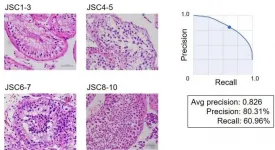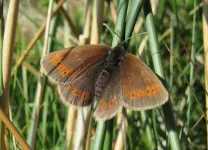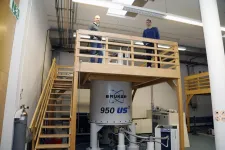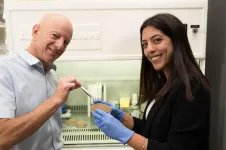In spring 2020, concerns about heart damage, especially inflammation, among athletes with COVID-19 led to recommendations for cardiac screening based on symptom severity before resuming training and competition. The preferred diagnostic test for heart inflammation is an MRI of the heart, or cardiac magnetic resonance imaging. The American College of Cardiology’s Sports & Exercise Cardiology Council’s standard recommendations, issued in May 2020, do not advise cardiac MRI as an initial screening test based on COVID symptoms alone, so researchers investigated if symptom severity was associated with heart inflammation or poor recovery after COVID-19.
“Our study results support an approach to cardiac screening guided by patient symptoms and severity of COVID illness in line with current recommendations from sports-cardiology groups before resuming exercise or sports,” said senior study author Ranjit R. Philip, M.D., pediatric cardiologist at Le Bonheur Children’s Hospital and assistant professor in pediatric cardiology at the University of Tennessee Health Science Center in Memphis.
From July 9, 2020 to October 21, 2020, researchers at the University of Tennessee Health Sciences Center reviewed health records to identify 137 college athletes (average age of 20, 68% male) who were referred for cardiac screening to return to play after testing positive for COVID-19. On average, the athletes were evaluated 16 days after testing positive for the COVID-19 virus. Nearly half of the participants were African American students, nearly half were white students, and 7% were Hispanic students. Of the 11 sports represented at three universities, more than a third of the athletes were football players, followed by dance, basketball, baseball, softball, tennis, soccer, cheer, track, volleyball and golf athletes.
Most (82%) of the athletes had COVID-19 symptoms; the symptoms were mild for the majority (68%); and none required treatment or hospitalization. The most frequent symptoms were the loss of smell/taste (58%), fever (less than 2 days, 42%), headache (41%) and fatigue (40%). Less frequently reported symptoms were shortness of breath (12%) and chest pain/tightness (11%). African American and Hispanic athletes were more often symptomatic compared to white athletes (86% and 100% vs. 75%, respectively). No differences in symptoms or severity were found based on gender or sport.
All of the athletes underwent initial heart imaging tests, including ultrasound of the heart and electrocardiogram to screen for possible heart damage, and received a blood test (troponin level). Troponin is a protein that is released in the blood and found in the muscles of the heart when there is heart damage. Only participants who had abnormal test results received a cardiac MRI.
Researchers found:
Less than 4% (5) of the 137 athletes showed heart abnormalities on initial screening tests. Further screening via cardiac MRI of the 5 athletes identified found no heart damage or inflammation. After COVID-19 recovery, all athletes were able to resume their full training and competition regimens without any complications. “We were encouraged to find so few abnormal tests in these athletes as well as negative cardiac MRIs in those who did have an abnormal test during the initial screening, and no athlete had any problems after returning to exercise and sport,” said Benjamin S. Hendrickson, M.D., co-author and pediatric and congenital cardiologist with Le Bonheur Children’s Hospital and assistant professor of pediatrics (cardiology) at the University of Tennessee Health Science Center.
“Our findings may offer reassurance to high school athletes, coaches and parents where resources for testing can be limited,” Philip added.
Limitations that could have affected the study’s results include the lack of a control group without COVID-19 and the use of a regular as opposed to the high-sensitivity troponin test.
The new study by Dr. Philip and colleagues also confirms recent research published April 17 in Circulation, that found no adverse cardiac events related to SARS-CoV-2 infections observed among more than 3,000 collegiate athletes during short-term clinical surveillance. Findings also suggested a safe return-to-play without cardiac testing for asymptomatic or mildly symptomatic athletes.
Other efforts to track how COVID-19 impacts college athletes includes an initiative from the American Heart Association and the American Medical Society for Sports Medicine (AMSSM) to accelerate a critical new research initiative studying cardiac conditions in athletes. The collaborative data registry, started in January 2021, aids research on COVID-19 and, long-term, it will develop a deep knowledge base on cardiac disease in athletes beyond the pandemic.
INFORMATION:
Other co-authors are Ryan E. Stephens, NP-C, M.B.A.; James V. Chang, M.D.; Jacob M. Amburn, M.S.; Lindsey L. Pierotti, R.D.; Jessica L. Johnson, R.N.; John C. Hyden, M.D.; and Jason N. Johnson, M.D., M.H.S. Author disclosures are listed in the manuscript.
The study received no external funding.
Additional Resources:
Available multimedia is on right column of release link - https://newsroom.heart.org/news/small-study-shows-heart-damage-after-covid-19-uncommon-in-college-athletes?preview=57c951df4c8390dac48fbf41bf4bb2e1
After May 10, view the manuscript online.
Athletes unlikely to develop cardiac complications from COVID, study shows
AHA News: A closer look at COVID-19 and heart complications among athletes
COVID-19 CVD registry details disparities among patients hospitalized with COVID
American Heart Association coronavirus (COVID-19) resources for the public
American Heart Association COVID-19 Newsroom
American Heart Association coronavirus (COVID-19) resources for health care professionals
American Heart Association announces COVID-19 patient data registry
Follow AHA/ASA news on Twitter @HeartNews
Follow news from the AHA’s flagship journal Circulation @CircAHA
Statements and conclusions of studies published in the American Heart Association’s scientific journals are solely those of the study authors and do not necessarily reflect the Association’s policy or position. The Association makes no representation or guarantee as to their accuracy or reliability. The Association receives funding primarily from individuals; foundations and corporations (including pharmaceutical, device manufacturers and other companies) also make donations and fund specific Association programs and events. The Association has strict policies to prevent these relationships from influencing the science content. Revenues from pharmaceutical and biotech companies, device manufacturers and health insurance providers are available here, and the Association’s overall financial information is available here.
About the American Heart Association
The American Heart Association is a relentless force for a world of longer, healthier lives. We are dedicated to ensuring equitable health in all communities. Through collaboration with numerous organizations, and powered by millions of volunteers, we fund innovative research, advocate for the public's health and share lifesaving resources. The Dallas-based organization has been a leading source of health information for nearly a century. Connect with us on heart.org, Facebook, Twitter or by calling 1-800-AHA-USA1.









